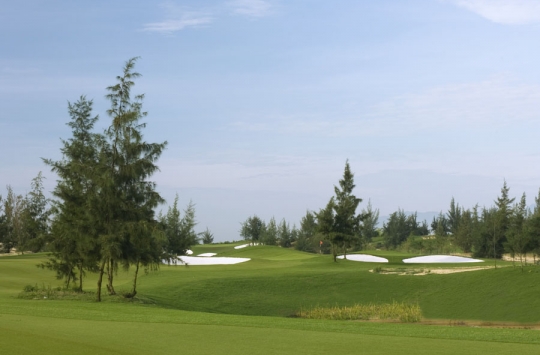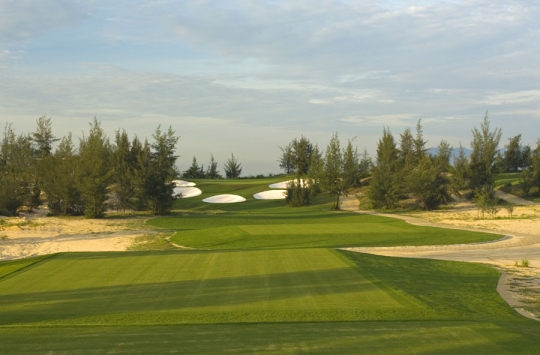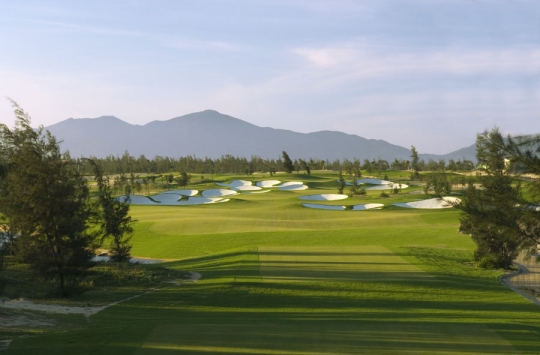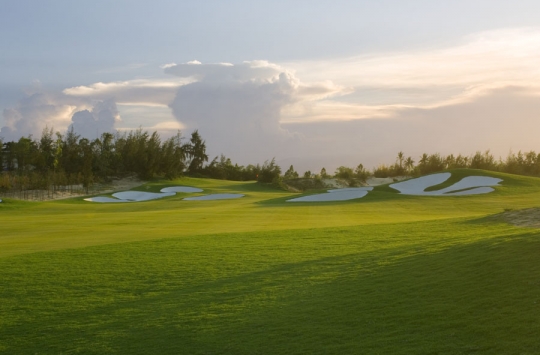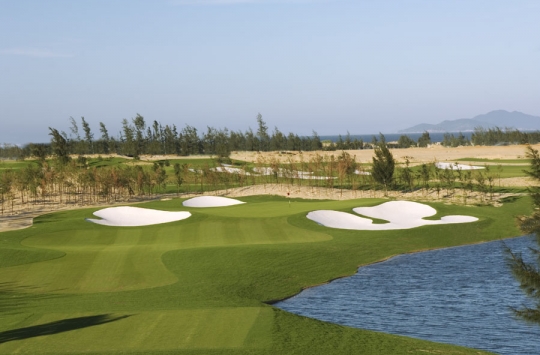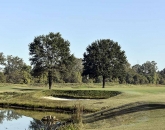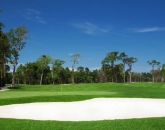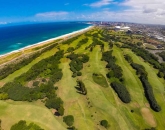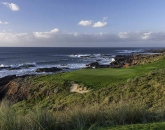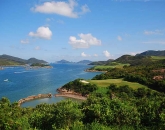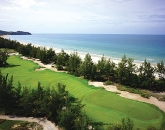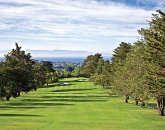“Follow me. I want to show you this bunker,” says Jon Tomlinson, after I tee off on the 12th hole at Montgomerie Links, a just-opened Colin Montgomerie design along the central coast of Vietnam. There are—count ‘em—18 salt-white bunkers strewn about the elevated green on the horizon. But instead of heading down the 540-yard, trap-speckled fairway, the club’s general manager cuts behind a snack shack, set on a ridgeline that slopes down to vibrant rice paddies on one side and new golf course on the other. Once around back, he stops.
“Check it out,” he says, pointing to the ground, where there appears to be a series of storm drains, separated by a few inches. Then he kicks some debris away from the dark slits. I can almost see the silhouettes of American soldiers peering down the barrels of their M-16s. “Real bunkers here, mate. There’s another one over on 11. Talk about provenance. How many courses have features like that?”
None that I know of. And that’s counting what exists in Vietnam, a country ravaged by war for the most part of the last century but patching itself back together nicely through some of Southeast Asia’s most attractive tourism-driven projects.
Nowhere is the transformation more evident than in and around Danang, where miles of dunes once bedecked only by concrete U.S. military hangars are being dressed up with high-end hotels like The Nam Hai (so impressive Travel + Leisure magazine recently voted it “World’s Best Resort” in its annual design competition), snazzy residential towers and championship-caliber golf courses.
The game may have been played in this region before—in 1966, two-time US Open champion Billy Casper and a Marine colonel hit into tractor tires on China Beach during a morale-boosting tour organized by the US State Department—but Montgomerie Links is the first real layout to come on line here. And while Greg Norman will follow with a design of his own across the street, don’t expect Monty’s creation to fall off golfers’ must-play lists anytime soon.
Starting August 1, nine of its planned 18 holes will be open for public play. All will be memorable—and different from anything seen in Vietnam, or even Southeast Asia, before.
In true links style, fairways are wide and mown tight; greens are big and dynamic; and bunkers are deep and penalizing. Contemporary twists come in the form of a handful of water hazards, the wall-to-wall paspalum turf ideal for tropical climes, earth-tone cart paths, and bunkers so white they’d make Augusta National’s jealous.
“We had the sand trucked in from Hue, a couple hours north of here,” says Tomlinson. “The contrast it creates with the fairways is striking. It will look even cooler once the native grasses start feeding in around the bunkers’ edges.”
The current experience at Montgomerie Links begins, appropriately, at the 581-yard first hole, a par 5 that bends ever so slightly left to a well-guarded, elevated green. A short wall—which will eventually be hidden by a row of casuarina pines—runs the entire length of the left side, tempting players to bail out right off the tee to avoid OB. For now, that’s a safe enough strategy; fescue and flowers are just starting to take hold there, making recovery feasible.
The temporary routing then veers over to the par-4 ninth, which runs parallel to one but plays in the opposite direction. At 500 yards from the tips and into the wind, it is—and will forever be, one could easily surmise—the number 1 stroke index. A lake half encompasses the green, just for good measure.
“The course is not unfair,” says Tomlinson, as he taps in for par. “But some of these holes will definitely separate the men from the boys. This, obviously, is one of them.”
The next one is another, a 470-yard par 4 that will eventually play as number 13. The fairway is sprawling and connects with 18, but the uphill approach will test the nerves of even the best. Thick brush lurks left, while a steep bank—a dune, in fact—guards the right side, ready to reject errant shots into a small pond below.
The next four holes offer somewhat of a break: the par-3 14th is downhill with stunning views of the South China Sea, about a half-kilometer away; the par-4 15th is a short dogleg left around water; the par-5 12th is a birdie hole if those bunkers are negotiated correctly with the second shot; and the par-4 10th is a medium-length dogleg right.
The final two holes—the par-3 11th and the par-4 eighth—are just what a conclusion ought to be: demanding and outstanding. Reminiscent of number 5 at Australia’s iconic Royal Melbourne, the former plays uphill with little room for error—trees and waste areas frame the green, which possesses a false front that repels anything short. The lush Annamite Range, in the background, is a distraction, too.
The last calls for a long, straight drive in order to get a good look at the green, 415 yards from the tee box and protected front right by—what else?—a huge trap.
“I get bored playing courses in Asia,” says Tomlinson, a 10-time Australian PGA tournament winner who managed courses in China for five years. “So many of them, even for the average player, are driver-wedge, driver-wedge. Here, with this course, there’s none of that. You’ll use every club in the bag. I practically did today, and we only played nine holes.”
-921-
[SIDEBAR]
Bunkered at the sandy 12th
This par-5 doesn’t have the sea views of the par-3 14th or the unique, peek-a-boo green of the par-4 13th, but, frankly, it doesn’t need them—it’s as strong of a journey, from start to finish, as a player will find.
From the box, it’s a drive through a chute of casuarina pines to a fairway littered with sand traps. There are 18 of them all told, and all look meaner than broken glass. They’re big, they’re deep and they become more prominent around the front of the green.
That’s not to say you can go long, left or right of the ultimate target—shots to those spots will simply find their way into collection areas, which will have high handicappers gratefully reaching for their putters and better players puzzling over which club to use.
“Twelve is a perfect example of what kind of a challenge awaits at Montgomerie Links,” says Tomlinson. “It changes complexion the farther along you go. And even if you’re striking the ball well, you better have confidence and touch in your short game, because it’s going to be tested.”
Click here to see the published article.


